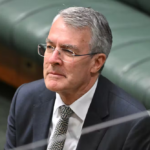Remembering Pete Seeger

Pete Seeger, the banjo-playing folk singer, was in the forefront of every major reform movement in twentieth-century America. Born into a family with radical roots, he found his own way into the labor struggle, the civil rights crusade, the anti-Vietnam War effort, and finally the environmental movement. Hailed as the father of the folk music revival in the 1950s and 1960s, he used music to plead for reform, both in the United States and around the world.
Pete’s background shaped his early life. His father Charles was a musicologist and composer who started the music department at the University of California, Berkeley. For a time a member of the Communist Party, he lost his job during World War I as a result of his pacifism. His mother Constance was a concert violinist and encouraged Pete’s interest in music. While a student at Harvard, Pete was a member of the Young Communist League, railing against the fascist forces crushing freedom in Europe and Asia without really knowing what he wanted to do.
Only after leaving Harvard toward the end of his second year did Pete find his own way, both politically and musically. While a student at Avon Old Farms, an exclusive private school, he had begun to play the four-string banjo, and later moved on to the more versatile five-string version. Working for musicologist Alan Lomax at the Archive of American Folk Song at the Library of Congress in Washington, D.C., he learned a good deal about the music he was transcribing.
Lomax gave him a chance to perform publicly for the first time in 1940 at a benefit concert for migrant farm workers at the Forrest Theater near Broadway in New York City. There he met guitar player Woody Guthrie, older and better known, and the friendship that developed lasted for many years. Guthrie took Seeger out West, riding freight trains and learning how to support himself playing in bars, and in the process changed his life.
After that trip, Pete gravitated to New York, where he met Lee Hays, a burly singer who shared his political views. Together they assembled a group called the Almanac Singers, which supported working men and women and sang for labor gatherings as the union movement of the 1930s moved ahead. One of Pete’s first songs, written together with Hays, was “If I Had a Hammer,” which called out for a more peaceful and harmonious world.
Drafted into the Army during World War II, Pete spent several years in Saipan, and then returned to the United States to join his wife Toshi and to resume his political and musical activities. With friends, he founded an organization called People’s Songs to encourage the writing and singing of new songs to make the world a better place.
As People’s Songs, which operated on a shoestring, fell apart, Pete began to sing with a new group called the Weavers. Its smooth and melodious sound caught the attention of the country and the group became enormously popular, with its Lead Belly song “Good Night Irene” reaching the very top of the national charts.
Then Pete’s leftwing past came back to haunt him. Though he had only been a member of the Young Communist League for a short while, he and others found themselves under attack in the Red Scare of the 1950s. The Weavers began to lose bookings and eventually disbanded, and Pete and others found themselves called before the House Committee on Un-American Activities to testify about their radical history.
Unwilling to rely on the Fifth Amendment to the United States Constitution which protected people from self-incrimination, he invoked instead the First Amendment, which guaranteed the right to free speech. Charged with contempt for failing to cooperate with Congress, he was indicted and convicted in federal court, though on appeal the conviction was overturned on a technicality.
Without a job, Pete began to move out on his own. He visited schools, colleges, summer camps, and other gatherings, and in the process sang about the causes that were consuming the United States. In the process, he developed a constituency of young people who embraced the folk music movement as it began to catch on.
Meanwhile and with a growing sense of commitment (particularly after the attacks he had to weather for his political beliefs), he gravitated toward the fledgling civil rights movement. In 1955, a year after the Supreme Court had declared school segregation unconstitutional in the landmark Brown v. Board of Education ruling, Pete read about Rosa Parks’ arrest for refusing to move to the back of a bus in Montgomery, Alabama, in violation of the city’s Jim Crow laws mandating the separation of races. Sympathetic, Seeger offered support and eventually went south to sing at rallies for the cause.
He also had a hand in crafting what became the marching song of the movement. Visiting the Highlander Folk School in Tennessee in 1947, which trained activists to fight injustice on all fronts, he learned a song called “I Will Overcome” from music director Zilphia Horton. It derived from an older black spiritual called “I’ll Overcome Someday,” which was then sung by striking textile workers whom Horton had heard. Pete sang the song more quickly with a banjo rhythm, and also changed “I Will Overcome” to “We Shall Overcome.” Eventually it reached Guy Carawan, a guitar-playing graduate student who later succeeded Horton as music director at Highlander after her death.
In 1960, he organized a weekend gathering at Highlander for young civil rights activists, and invited Seeger to help him with the music. Carawan taught the song, played more slowly, to the volunteers, and it became the high point of the weekend. Several weeks later, at another conference in Raleigh, North Carolina that led to the formation of the Student Non-Violent Coordinating Committee (SNCC), the volunteers called out for “We Shall Overcome,” and began to sing it with crossed arms, holding on to people on either side as a sign of solidarity.
As Black Power came to the fore toward the end of the 1960s, Seeger began to question his own role in the movement. Still convinced of the need for social and racial justice, he nonetheless found himself gravitating toward another cause – the ill-fated struggle in Vietnam. Like many Americans, he believed that the war was a terrible mistake.
He began to write and sing songs that highlighted both the absurdity and the destructiveness of the conflict that tore the United States apart. “Bring ‘Em Home” was a plea to end the war, but his favorite song was “Waist Deep in the Big Muddy,” which told the story of the foolish stubbornness of an Army captain leading troops across the Mississippi River in 1942. Despite warnings that the river was too deep and dangerous to cross, the captain persisted until his own inevitable demise, in a savage metaphor for the war in Vietnam.
As American involvement in Vietnam began to wind down, Pete became interested in another cause. The cabin he had built with his own hands in Beacon, New York looked out on the Hudson River, now miserably polluted. Long sympathetic to environmental activism, he became even more interested after reading Rachel Carson’s path-breaking book Silent Spring, about pesticide poisoning and environmental pollution.
As he began to sail in a small boat on the Hudson, the pollution revolted him. Pete began to dream about building a sloop, like the large boats of the past, and sailing it up and down the river to highlight environmental awareness. He was instrumental in raising money to build the sloop, christened the Clearwater in 1969. Volunteers worked on the boat, which still travels the Hudson River today.
Seeger’s activism left a rich legacy by the time he died in 2014 at the age of 94. His songs, including “If I Had a Hammer,” “Where Have All the Flowers Gone,” and “Turn, Turn, Turn,” called out for a more peaceful world. “We Shall Overcome” remains the marching song in the continuing quest for civil rights, both in the United States and around the globe. Pete, who had come to his activism from a sense of the need to address injustice in the world, was fond of telling a story that was a kind of personal parable.
There was, he said, a small peace demonstration in Times Square in New York City in the 1950s. An observer scoffed at a Quaker carrying a sign, and said, “Do you think you’re going to change the world by standing here at midnight with that sign?” The Quaker responded, “I suppose not, but I’m going to make sure the world doesn’t change me.” Pete remained, like that Quaker, committed to a better world, and his example resonates with us all.
This article was published by Transformation.
Allan M. Winkler is the Professor of History Emeritus at Miami University in Ohio. A prize-winning teacher, he is author of 11 books including Home Front U.S.A.: America during World War II and “To Everything There Is a Season”: Pete Seeger and the Power of Song.











